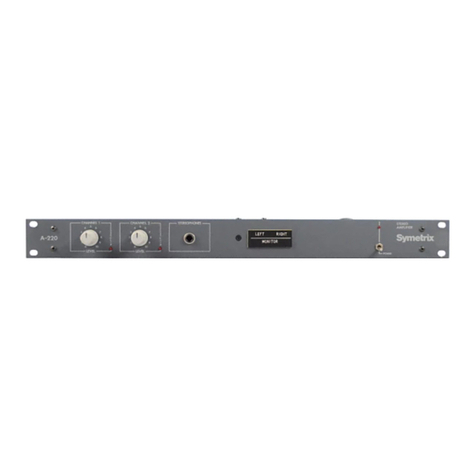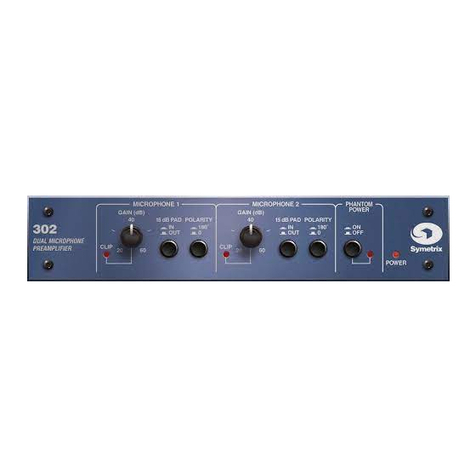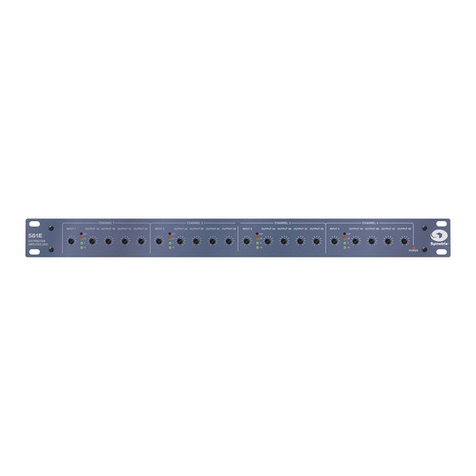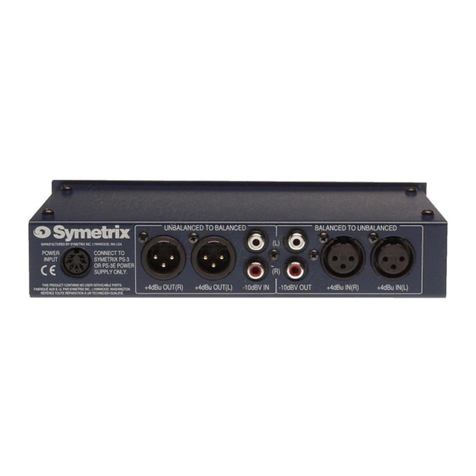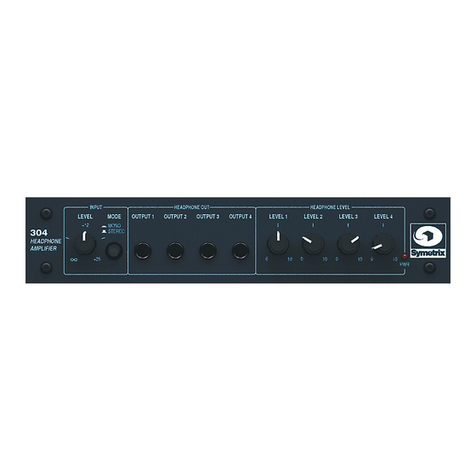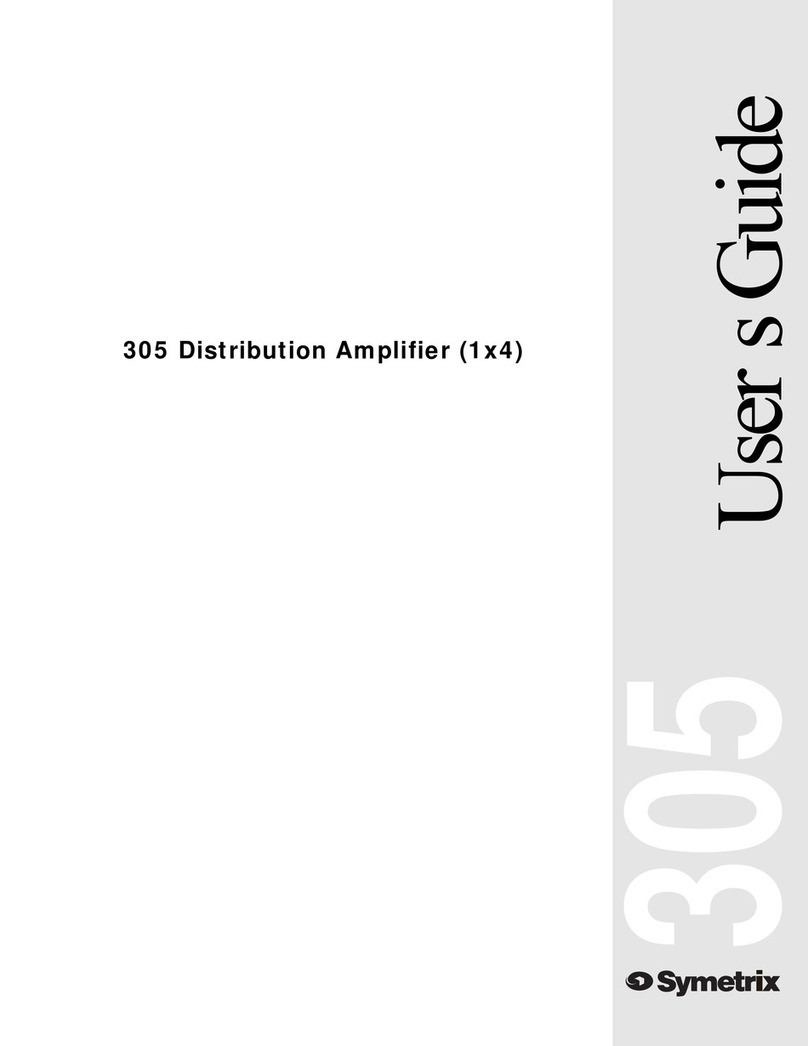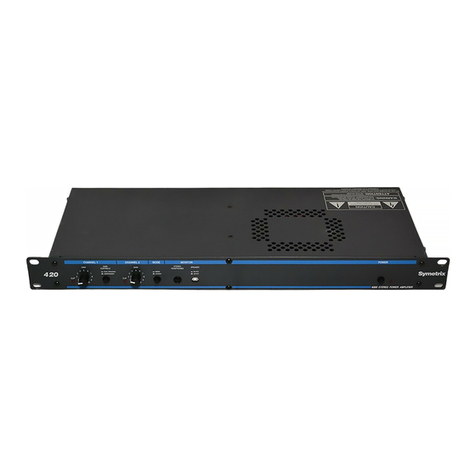
www.SymetrixAudio.com
1
!
The lightning flash with arrowhead symbol
within an equilateral triangle is intended to
alert the user of the presence of uninsulated
“dangerous voltage” within the product’s
enclosure that may be of sufficient magnitude to
constitute a risk of electric shock to persons. The
exclamation point within an equilateral triangle
is intended to alert the user of the presence of
important operating and maintenance (servic-
ing) instructions in the literature accompanying
the product (i.e. this User’s Guide).
1
!
CAUTION: To prevent electric shock, do not use
the polarized plug supplied with the unit with
any extension cord, receptacle, or other outlet
unless the prongs can be fully inserted.
1
!
Power Source: The 304 Headphone Ampli-
fier hardware uses a separate external power
supply for domestic and export markets. Ensure
that your AC mains voltage matches that of your
power supply. Use only the power cord and
connector specified for the product and your
operating locale. A protective ground connec-
tion, by way of the grounding conductor in the
power cord, is essential for safe operation. The
appliance inlet and coupler shall remain readily
operable once the apparatus has been installed.
1
!
User Serviceable Parts: There are no user
serviceable parts inside your Symetrix product.
In case of failure, customers inside the U.S.
should refer all servicing to the Symetrix factory.
Customers outside the U.S. should refer all
servicing to an authorized Symetrix distributor.
Distributor contact
information is available online at
http://www.SymetrixAudio.com.
"7*4
/&1"40673*3
*MOFTFUSPVWFBMJOUFSJFVSBVDVOFQJFDFQPVSWBOUFOUSFSFQBSÊFMVTBHFS
4&&08/&34."/6"-70*3$")*&3%*/4536$5*0/4
4BESFTTFSBVOSFQBSBUFVSDPNQÊUFOU
3*426&%&$)0$&-&$53*26&
/PVTFSTFSWJDFBCMFQBSUTJOTJEF3FGFSTFSWJDJOHUPRVBMJGJFETFSWJDFQFSTPOOFM
$"65*0/
8"3/*/(
503&%6$&5)&3*4,0''*3&03
&-&$53*$4)0$,%0/05&9104&
5)*4&26*1.&/5503"*/03.0*4563&
%0/0501&/
3*4,0'&-&$53*$4)0$,
Important Safety
Instructions.
!Read these instructions.
@Keep these instructions.
#Heed all warnings.
$Follow all instructions.
%Do not use this apparatus near water. This
apparatus shall not be exposed to dripping or
splashing and no objects filled with liquids,
such as vases, shall be placed on the apparatus.
^Clean only with dry cloth.
&Do not block any ventilation openings. Install
only in accordance with the manufacturer’s
instructions.
*Do not install near any heat sources such as
radiators, heat registers, stoves, or other appa-
ratus (including amplifiers) that produce heat.
(This apparatus shall be connected to a mains
socket outlet with a protective earthing con-
nection. Do not defeat the safety purpose of the
polarized or grounding-type plug. A polarized
plug has two blades with one wider than the
other. A grounding type plug has two blades
and a third grounding prong. The wide blade or
the third prong are provided for your safety. If
the provided plug does not fit into your outlet,
consult an electrician for replacement of the
obsolete outlet.
BL Protect the power cord from being walked on
or pinched particularly at plugs, convenience
receptacles, and the point where they exit from
the apparatus.
BM Only use attachments/accessories specified by
the manufacturer.
BN Use only with the cart, stand,
tripod, bracket, or table speci-
fied by the manufacturer, or
sold with the apparatus. When
a cart is used, use caution when
moving the cart/apparatus combination to avoid
injury from tip-over.
BO Unplug this apparatus during lightning storms
or when unused for long periods of time.
BP Refer all servicing to qualified service person-
nel. Servicing is required when the apparatus
has been damaged in any way, such as power-
supply cord or plug cord is damaged, liquid
has been spilled or objects have fallen into the
apparatus, the apparatus has been exposed to
rain or moisture, does not operate normally, or
has been dropped.
Safety
1
Page
Before You Begin
What Ships in the Box
øA 304 hardware unit.
øOne PS-3 (115 VAC), PS-3E (230 VAC)
power supply.
øThis User’s Guide.
Getting Help
If you have questions beyond the scope of this
User’s Guide, contact our Customer Support Group
inthe following ways:
Tel: +1 (425) 778-7728
8:00 am to 4:30 pm
Monday through Friday,
Pacific Time
Web: http://www.SymetrixAudio.com
This device complies with part 15 of the FCC Rules. Operation is
subject to the following two conditions: (1) This device may not cause
harmful interference, and (2) this device must accept any interference
received, including interference that may cause undesired operation.
This Class B Digital apparatus meets all requirements of the Canadian
Interference-Causing Equipment Regulations
Cet appariel numerique de la classe B respecte toutes les Exigences
du Reglement sur le materiel brouilleur du Canada.

